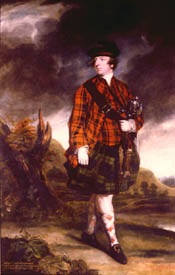John Murray, 4th Earl of Dunmore
John Murray, 4th Earl of Dunmore (1730 – February 25, 1809) was the British governor of the Province of New York from 1770 to 1771 and the Virginia Colony, from September 25, 1771 through the start of the American Revolutionary War begun in June 1775, until his departure to the New York Colony on New Years Eve, 1776. During his term as Virginia's colonial governor, from 1771 to 1774, he directed a series of campaigns against the Indians known as Lord Dunmore's War. The Shawnee were the main target of these attacks, and his purpose was to strengthen Virginia's claims in the west, particularly in the Ohio Country. Some have accused him of colluding with the Shawnees and arranging the war in order to deplete the Virginia militia and help safeguard the Loyalist cause, should there be an American Revolution.
The Revolution
From 1774 on, Dunmore was continually clashing with the Colonial Assembly. He left Williamsburg on June 8, 1775, retreating to his hunting lodge, Porto Bello, and had to hide on the British warship Fowey in the York River when the American Revolutionary War began. When he couldn't regain control of Virginia, he went back to England in July 1776.
He is noted for Lord Dunmore's Proclamation, November 7, 1775, whereby he offered freedom to enslaved Africans who joined his Army. This was the first mass emancipation of slaves in North America. He organised these Black Loyalists into the Ethiopian Regiment. After the Battle of Kemp's Landing, Dunmore became over confident. Tricked by a double agent he engaged the enemy at the Battle of Great Bridge, December 9, 1775. Following his defeat, he decamped his army onto the British fleet and retreated to New York. This played a large role in Dunmore's departure from Virginia.
Later life
From 1787 to 1796 he was governor of the Bahamas. Father of Lady Augusta Murray daughter in law of George III
Heritage
- Dunmore County, Virginia, formed in 1772, was named in his honor. However, as the American Revolution got underway, the citizens changed its name to Shenandoah County in 1778.
- "Porto Bello", the hunting lodge of Lord Dunmore, still stands on the grounds of Camp Peary in York County, Virginia. It is listed on the National Register of Historic Places. Access to the base is highly restricted, so the structure is not available for public viewing.
- The Dunmore Pineapple was built in 1761 before he left Scotland. The building is now owned by the National Trust for Scotland and is leased to the Landmark Trust who use it to provide holiday accommodation. The gardens are open to the public year round.
- Dunmore Street in Norfolk, Virginia was named for him. As the last royal governor, on New Year's Day in 1776, Lord Dunmore gave the order for the burning of Norfolk after leaving on a British warship. It is said that the naming of Dunmore Street was not to honor the governor, but to celebrate the place in Norfolk where he last set foot.
| Preceded by: Sir Henry Moore, Bart |
Royal Governor of New York 1770–1771 |
Succeeded by: William Tryon |
| Preceded by: William Nelson |
Crown Governor of Virginia 1771–1775 |
Succeeded by: — |
| Preceded by: William Murray |
Earl of Dunmore | Succeeded by: George Murray |
